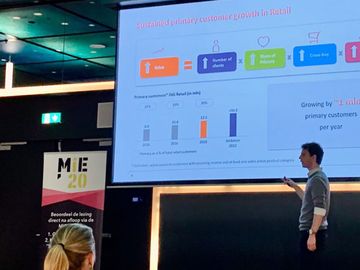The best tools for measuring your digital customer experience
You know you must keep improving your website visitors’ digital experience. However, what isn’t clear is which tools are best for achieving this goal. To make targeted optimizations, you need hard data that shows which elements are holding you back. This requires granular measurement of real customer experiences and user behaviors, to identify your weakest links and fix them.
You cannot rely on simple analytics to achieve this. To optimize the customer experience, you must understand what’s working, what isn’t, and why.
User Experience (UX) vs. Customer Experience (CX) – what’s the difference?
There’s a lot of confusion about the difference between user experience (UX) and customer experience (CX) – made worse from the fact that these two terms are sometimes used interchangeably. The difference between UX and CX however, is that UX is all about functionality and usability, whereas CX is about the total customer experience, including branding, information provided, communications, as well as UX features like navigation. So, while UX is an important part of the CX, it’s only part of the story.

It’s important to understand that the customer experience includes their total experience – including all the websites they visit before they land on yours.
By seeing yourself the way your customers see you, you can make optimizations with real impact. This might sound like an impossible task. However, using a combination of quantitative and qualitative measurements, you can gain a total view of the customer perspective – and adapt to match their expectations. Let’s look at the best tools for measuring customer digital experience, and see how they contribute to continuous improvement, better conversion, and more customers.
Analytics tools for conversion optimization
There are many tools available for supporting CX improvements and conversion optimization, using a quantitative analysis of user behavior. Some of these will be familiar to you already.
Best analytics tools for conversion optimization:
Google Analytics
You’ve almost certainly heard of Google Analytics. It’s the best-known tool for providing a general overview of your website analytics. At a glance, you can see how many visitors have landed on your website, your bounce rate, and how many have looked at certain pages. This can be thought of as a ‘thermometer’ for your website, giving a general picture of traffic and popular topics.
Hotjar
Want insight about website visitor behavior? Then Hotjar is for you. Hotjar records user behavior and creates heatmaps that show you which parts of your website get the most attention. You can immediately understand how your visitors interact with your website, and this can be useful for A/B testing.
Contentsquare
Contentsquare is useful for monitoring and visualizing human behavior on your own website. You can identify areas that cause frustration and friction, which you can prioritize and solve to create a smooth customer experience. Contentsquare uses data distracted from visitors’ data of your own website or mobile app. In the platform, you can benchmark your data against that of industry peers. The value is it makes analytics easy to use and understand, even if you aren’t a data analyst.
WUA
WUA uses a proven customer experience research model to track the behavior of hundreds of real people searching for a product or service you offer.
WUA gives you a clear picture of your current market position and share, highlights your relative performance benchmarked against your competitors, and gives clear priorities for optimization. Used as a continuous cycle, it makes it achievable to outsmart the competition and always offer the best experience on the market.
You can perform a quantitative analysis of your website’s performance, mapped against the buyer journey. Each optimization identified is therefore prioritized by how it affects conversion, using a validated research model. When defining priorities WUA takes the performance of your competitors into account. This way optimization priorities are way more powerful.
This methodology also means you get a total perspective that includes the customer experience on competitor websites, as well as your own. You additionally gain customer’s qualitative/open-answer data (see below) from WUA, as well as advice on strategic decisions about difficult issues such as backlog prioritization and achieving company-wide alignment with the customer perspective.
GetFeedback
GetFeedback (also known as Usabilla) is used to collect on-site feedback. With website and app surveys, you can quickly identify your visitors’ general pain points and start to optimize the digital experience based on their experiences.
Optimizely
Do you want to test the functions of your website? Then Optimizely is the tool you are looking for. With the platform you can perform extensive experiments and A/B split tests. And interpreting your data is also very easy.
How to use this kind of data
Analytics tools, like those above, can help you collect data about your visitors’ behavior. They can track where visitors come from, how long they stay, and when they leave. The power of these tools lies in the mountains of data they generate. With larger datasets, the more reliable your user experience analytics will be.
However, these tools can’t always tell you much about which specific elements are working, or why. They also don’t tell you how you compare in the minds of your visitors (because they do have other options, besides you).
For this, you need in-depth qualitative data. This can tell you why they prefer a competitor over you, or why a particular element (e.g., general appearance, value proposition, pricing, navigation, etc.,) fails to perform as you’d expect.
Without this kind of insight, any optimizations you make are (at least partially) guesswork, and rely on multiple rounds of laborious A/B testing to find the best options from the mix. Even then, you miss out on the optimizations you never even thought about.
Qualitative insights about Customer Experience
Qualitative data tells you the reason behind customer behavior. With qualitative data, you gain a new dimension of experience measurement. It helps to unpick the meaning of numerical data and show how to use it most effectively.
Now, when people abandon carts or fail to convert, you’ll know why.
With this insight, you can make targeted changes that address the reason for their behavior – and keep them engaged in your digital experience.
But qualitative data is hard to get, without directly asking customers for feedback. Tools like GetFeedback can help get an indication of how visitors rate specific pages. This can give a snapshot of sentiment, and more detailed surveys can tell you more – but how can you be sure the customers who respond to surveys reflect the way most visitors feel?
Without using the in-depth qualitative data from a verified research model, such as WUA’s, the only alternative is rigorous and repetitive testing.
Using a tool like Hotjar, you can conduct A/B tests that show how customers respond to changes you make. Inch by inch, you can get closer to the customer’s ideal website. This approach still does not tell you much about the reasons for the customer’s preference, however.
The best way to get in-depth customer experience research is by partnering with a specialist agency that can gather data from real people and turn this into actionable insights.
Agencies providing customer experience research:
Kantar
Kantar Data analytics and brand consulting, that is where Kantar is strong. They conduct brand and marketing communications research through quantitative and qualitative research, social media monitoring, consumer and shopping behavior analysis, advertising effectiveness, and public opinion. Perfect for understanding what people think of your brand.
WUA
In addition to the deep quantitative data, WUA also collects granular qualitative data from each of the 400+ participants in every study. Using open-answer questions, website visitors provide feedback about the most important website elements: what they liked, what they didn’t like, and why.
Because WUA measures the customer journey (not just your website), it gives a realistic picture of how customers search for – and find – the products and services you offer. This includes which websites they find, in what order they visit them, and how they perceive competitor websites too.
A great tool for optimizing the entire customer experience, and complemented by a consultancy service, if needed, to ensure your optimizations have maximum impact.
Ipsos and GFK
Ipsos and GFK conduct survey-based consumer market research for companies, brands, and institutions. These can help gain insights about general priorities for your customer group, and which products or services are most useful.
Nielsen
One option for understanding media consumption is Nielsen. They conduct measurement and data analysis of how people consume digital media, advertising, and digital content. Useful for prioritizing content marketing strategy and optimizing advertising at scale.
How to put this data to use?
By conducting market research on a large scale, you gain a new understanding of your own analytics and quantitative data. The larger your dataset, the more confidently you can draw conclusions from it.
However, the most valuable data reflects the customer digital experience as accurately as possible. Because your visitors will be checking the competitor’s websites too, this should be part of your measurement. Only then can you truly understand the customer’s perspective.
This makes the importance of other tools more important: how do you still get a complete insight into the entire user experience?
Eyeing-up the competition
To understand the customer experience fully, you need data about your competitors’ websites too, and an idea of how your digital experience measures up.
If you’re restricted to just the data from your own website, you have only a small piece of the puzzle. Knowing your conversion rate is 3% today only tells you that you’re losing 97% of your potential customers – and you still don’t know why.
This is why it’s essential to benchmark your performance against the competition. Is 3% conversion good for your industry? What conversion rates do your biggest competitors have? The only way to be sure is to measure your biggest competitors’ conversion rates and compare. And if they’re doing something better than you, you need to know about it.
This is why we created the WUA dashboard. It provides a complete overview, based on research on the opinions of at least 400+ consumers. With both qualitative and quantitative data, you can see how you’re performing compared to the market and your direct competitors. You can see where you are ahead (or behind), and which optimizations have the greatest effect on your conversions. This makes it easier to outsmart your competitors.
Give your customers the best
To win their custom, you need to offer website visitors the best experience. In other words, it needs to be the best website they visit.
Website analytics are an essential part of this because they can help give a general picture of traffic. But these are just ‘footprints’. They don’t tell you who the customers are, where they’ve been, or what they thought about your digital experience. You need qualitative data, and a measurement of their whole journey – including other websites.
You can only get qualitative data about your website and your competitors by gathering it actively, using a robust research model that ensures results reflect your real customers. This is something we excel at.
At WUA, we’re passionate about helping brands offer their customers the best possible digital experience. We have the tools and expertise ready to help you elevate your website, so you can outpace the competition and win more customers.



